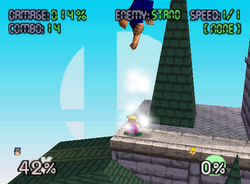
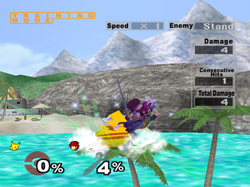
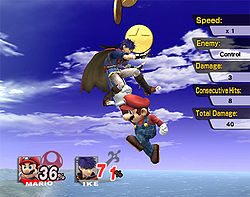
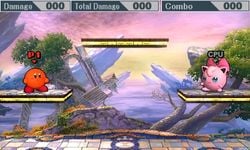
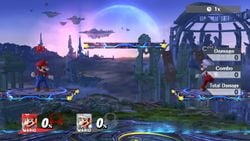
Training Mode (トレーニング, Training), or simply Training in Brawl, is a mode available in all games of the Super Smash Bros. series where the player can manipulate overall gameplay of a match and experiment with the CPU without the restrictions of standard Versus Mode. The mode's features, behaviors, and properties vary throughout the series.
Overview
As implied by its name, Training Mode is intended to allow players to practice using characters in a non-serious setting. All matches within the mode are actually Time matches of infinite length, as seen on the Jumbotrons featured in the Pokémon Stadium stages. The player can use any character they wish and select one CPU character as their opponent. Any stages available to the player can be used in the mode, including Smash 4's Omega Form stages.
Interestingly, Stale-Move Negation is not present in the mode for Brawl or SSB4. Additionally, in SSB4, the rage mechanic is ignored and pausing while in Training Mode will freeze the stage and all such elements, but not the characters or items.
Overlay
Within Training mode, a specialised UI overlay, unavailable in any other mode, is displayed on the screen in order to show data relevant to gameplay. The overlay is always present in Smash 64, Melee, and Smash 4, but is disabled by default in Brawl.
The overlay contains information regarding:
- Speed: Shows the speed at which the game is running. Not present in Smash 3DS.
- Enemy: Shows the behaviour set by the player for any CPUs in play. Not present in Smash 4.
- Damage: Displays amount of damage most recent attack inflicted by the player.
- Combo/Consecutive Hits: Displays how many hits the player has attained on the opponent in one standard combo; this data is saved, with the longest combo done by each individual character being displayed on the character select screen for the mode. The counter in the overlay will top out at 999, though the mode can display higher combos on the character select screen. Named "combo" in SSB64 and Smash 4 and named "consecutive hits" in Melee and Brawl.
- Total Damage: Added in Melee, this displays how much damage the present combo has done on opponents. Like the Combo counter, it maxes out at 999.
Available modifiers
In addition to allowing players to train against an ordinarily idle opponent or to perfect their timing in combos or other advanced techniques, the player has the option of manipulating the environment of the stage or gameplay. Initially limited in Smash 64, modifiers within later games were more advanced.
Modifying the match's parameters requires using a specialised menu accessed by pressing the pause button; while this menu stops the CPU from performing actions, it does not actually pause the battle, and so items on the stage and other stage hazards can potentially harm the player while they apply modifiers. As the Nintendo 3DS has two screens, the bottom touch screen can be used to manipulate the environment without having to pause the game.
- Speed: Allows the player to alter the gameplay speed of the match, though some aspects of gameplay, such as transformation Final Smashes and stage hazards, are unaffected by this setting. The original SSB64 allows for standard speed (1x), as well as factors of 2/3x, 1/2x, and 1/4x; Melee added factors of 1.5x and 2x, though 2x speed was removed from Brawl onward. Smash 3DS also removed 1.5x speed, but added a second version of 1/2x and 1/4x where time only advances while the L button is held down (regardless of the player's control settings). Smash Wii U re-added the 1.5x speed.
- Item: Allows player to spawn an item of their choice on the stage. As the pause menu does not stop gameplay, items can interact with the environment while the stage is paused.
- CP/CPU: Modifies the behaviour of the computer-controlled players, such as to make them stand still, constantly jump, or evade the player's attacks. For a list of all available behaviors in various games, see List of CPU modes.
- No. of CPUs: Allows the player to decide on how many CPUs to include in the match. Introduced in Melee, the player can spawn one, two, or three opponents, though they will all be of the same character as the one selected prior to the match. If "Attack" or "Control" is selected for their behaviour, they will not be harmed by each other's attacks.
- CPU Damage: Changes the damage all computer-controlled opponents have. Can be anywhere from 0 to 999, and is set upon closing the pause menu (so pausing the game to modify other values will reset damage to the value set). From Smash 4 onward, it changes the damage all players have.
- Camera: Allows the player to modify how the Camera looks at the stage. Smash 64 allows for "Normal" and "Close-up", the latter of which zooms in on the player; Melee adds a "Free" option that zooms in the camera as well, but to a lesser extent than the renamed "Zoom" option. Brawl removed the "Free" option. Smash 4 kept the Zoom and Normal modes, while also adding Fixed-Camera, zooming the camera out so that all of the stage is visible.
- Reset: Completely resets the stage and sends all characters back to their original spawn points. All items are removed from play, and the stage returns to its original form; damage percentages are reset to 0. The music track that was playing will also restart. Nonexistent in Brawl.
- Exit: Sends the player back to the character selection screen.
The bottom screen in Super Smash Bros. for Nintendo 3DS
The pause screen in Super Smash Bros. for Wii U
Rewards
In Melee
- Getting an 11 hit or higher combo will grant the player the Metal Box trophy.
- Getting a 21 hit or higher combo will grant the player the Lip's Stick trophy.
- Getting a total of 125 combined combos will grant the player the Bunny Hood trophy.
In Brawl
- Getting a 10 hit combo will grant the player the Banana Peel trophy
- Getting a total of 400 combined combos will grant the player the Ouendan trophy.
In Super Smash Bros. for Nintendo 3DS
- Getting a 10 hit or higher combo will grant the player the Huge Header custom special move.
- Getting a 40 hit or higher combo will grant the player the Beam Sword Agility Badge equipment.
- Getting a 100 hit or higher combo will grant the player the Protective Gear outfit.
- Getting a total of 400 combined combos will grant the player the Leaper Ability Badge.
In Super Smash Bros. for Wii U
- Getting a 30 hit or higher combo will grant the player the Title Theme (Wii Sports Resort) music track.
- Getting a 50 hit or higher combo will grant the player the Unharmed Speed Demon Agility Badge equipment.
Character Loading Input Delay
In Brawl, after adding additional CPU's to a match, those CPU's do not function correctly when set to Control. It is unclear exactly what causes it, but they do not act on the same frame as another character using the same input, causing both input delays and ignored inputs. Opening and closing the training menu (by pressing the pause button) fixes this until a new CPU is added. This does not occur in Melee.
Trivia
- In Super Smash Bros., the background of each stage is changed to the Smash Bros. emblem and the music for each stage is changed to the Training Mode theme.
- In Super Smash Bros. Melee, the most recent Pokémon to be unleashed from a Poké Ball in Training Mode will either be the second Pokémon that appears in a standard Versus match, or the first in a Single Player mode.
- In Brawl, if Player 1 uses a trapping Final Smash on any spawned players and then despawns them, the player will resume the Final Smash on nothing.
- In Smash 4, the CPU number and behaviour cannot be changed if any player possesses a Smash Ball, the former of which prevents the situation described above from happening (Final Smashes attacking nothing). Items also oddly cannot be spawned while any character is in hitstun or in the tumbling animation.
- When CPUs are set to Control in Super Smash Bros. for Wii U, they will remain with a grey box and CPU tag, but will use human player colors for their shield, launch indicators and Villager's Balloon Trip (for example, the first CPU will use Player 2's blue color). This was also the case for the shield and blast line color in Brawl.
- If a character in Training Mode has All-Round Trade-Off Equipment they will start with 0% damage instead of 60%. This can be fixed by pushing Reset in the training menu.
- The only thing that overrides the stage freezing that occurs when bringing up the menu in Smash 4 is the clock present in Smashville and Town and City.
- In Smash 4, if a player takes control of a dummy and breaks a Smash Ball, the CPU behaviour cannot be changed until the Final Smash is used.
| Super Smash Bros. menu items | |
|---|---|
| VS Mode | VS Start (Team Battle) · Rule · Time / Stock · VS Options |
| 1P Mode | 1P Game · Training Mode · Bonus 1 Practice · Bonus 2 Practice |
| Option | Sound · Screen Adjust · Backup Clear |
| Data | Characters · VS Record · Sound Test |
| Unused | Debug menu |
| Super Smash Bros. Melee menu items | |
|---|---|
| Vs. Mode | Melee (Time · Stock · Coin Battle · Bonus · Team Battle) · Custom Rules · Special Melee · Tournament Mode · Names |
| 1-P Mode | Regular Match (Classic Mode · All-Star Mode · Adventure Mode) · Event Match · Stadium (Target Test · Home-Run Contest · Multi-Man Melee) · Training |
| Trophies | Gallery · Collection · Lottery |
| Options | Rumble · Sound · Screen Display · Language · Erase Data |
| Data | Snapshots · Melee Records · Sound Test · Archives (NTSC only) · How to Play (PAL only) |
| Unused | Debug menu · Debug sound test menu |
| Super Smash Bros. Brawl menu items | |
|---|---|
| Group | Brawl (Time · Stock · Coin Battle · Team Battle) · Rules · Special Brawl · Rotation · Tourney · Names |
| Solo | Classic · All-Star · Adventure Mode: The Subspace Emissary · Events · Stadium (Target Smash!! · Home-Run Contest · Multi-Man Brawl · Boss Battles) · Training |
| Wi-Fi | Spectator Mode · With Anyone · With Friends |
| Vault | Trophies & Stickers (Trophy Gallery · Trophy Hoard · Coin Launcher · Sticker Album · Sticker Center) · Stage Builder · Album · Challenges · Replays · Masterpieces · Chronicle |
| Options | Screen · Deflicker · Rumble · Controls · Sound · My Music · Erase Data |
| Data | Movies · Records (Group Records · Brawl Records · Notices) · Sound Test |
| Super Smash Bros. for Nintendo 3DS menu items | |
|---|---|
| Smash | Smash (Solo · Group · Time · Stock · Team Battle) · Rules |
| Smash Run | Solo · Group · Custom · Select Music |
| Games & More | Classic · All-Star · Stadium (Multi-Man Smash · Target Blast · Home-Run Contest) · Training · Custom · amiibo · Vault (Trophies · Trophy Rush · Album · Replays · Sounds · Records · Tips) · Options (Controls · Sound · Character Outline · Damage Display · Internet Options) |
| Online | Spectator Mode · With Anyone (For Fun · For Glory) · With Friends · Conquest · Share |
| Other | Challenge · StreetPass · Wii U |
| Super Smash Bros. for Wii U menu items | |
|---|---|
| Smash | Smash (Time · Stock · Coin Battle · Team Battle) · 8-Player Smash · Special Smash · Rules · Controls |
| Games & More | Classic · All-Star · Stadium (Target Blast · Home-Run Contest · Multi-Man Smash) · Training · Events · Special Orders (Master Orders · Crazy Orders) · Custom · Stage Builder · amiibo · Vault (Trophies · Trophy Rush · Album · Replays · Movies · Sounds · Records · Tips · Masterpieces) · Options (Controls · Sound · My Music · Internet Options) |
| Online | Spectator Mode · With Anyone (For Fun · For Glory) · With Friends · Online Events (Tourney · Conquest) · Share |
| Other | Challenge · Smash Tour · 3DS |